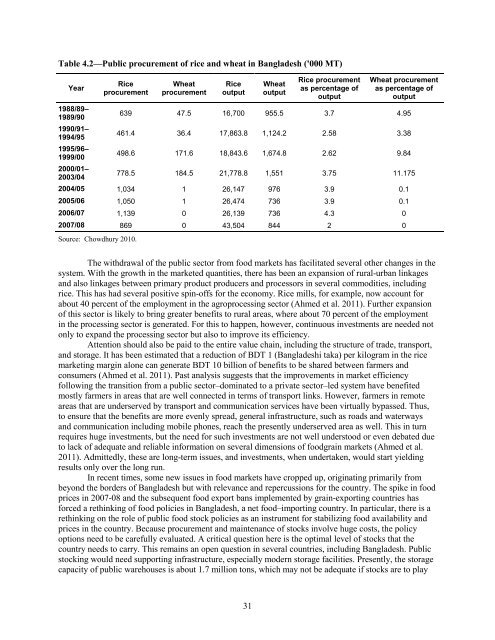Review of Input and Output Policies for Cereal Production in ...
Review of Input and Output Policies for Cereal Production in ...
Review of Input and Output Policies for Cereal Production in ...
Create successful ePaper yourself
Turn your PDF publications into a flip-book with our unique Google optimized e-Paper software.
Table 4.2—Public procurement <strong>of</strong> rice <strong>and</strong> wheat <strong>in</strong> Bangladesh ('000 MT)<br />
Year<br />
Rice<br />
procurement<br />
Wheat<br />
procurement<br />
Rice<br />
output<br />
31<br />
Wheat<br />
output<br />
Rice procurement<br />
as percentage <strong>of</strong><br />
output<br />
Wheat procurement<br />
as percentage <strong>of</strong><br />
output<br />
1988/89–<br />
1989/90<br />
639 47.5 16,700 955.5 3.7 4.95<br />
1990/91–<br />
1994/95<br />
461.4 36.4 17,863.8 1,124.2 2.58 3.38<br />
1995/96–<br />
1999/00<br />
498.6 171.6 18,843.6 1,674.8 2.62 9.84<br />
2000/01–<br />
2003/04<br />
778.5 184.5 21,778.8 1,551 3.75 11.175<br />
2004/05 1,034 1 26,147 976 3.9 0.1<br />
2005/06 1,050 1 26,474 736 3.9 0.1<br />
2006/07 1,139 0 26,139 736 4.3 0<br />
2007/08 869 0 43,504 844 2 0<br />
Source: Chowdhury 2010.<br />
The withdrawal <strong>of</strong> the public sector from food markets has facilitated several other changes <strong>in</strong> the<br />
system. With the growth <strong>in</strong> the marketed quantities, there has been an expansion <strong>of</strong> rural-urban l<strong>in</strong>kages<br />
<strong>and</strong> also l<strong>in</strong>kages between primary product producers <strong>and</strong> processors <strong>in</strong> several commodities, <strong>in</strong>clud<strong>in</strong>g<br />
rice. This has had several positive sp<strong>in</strong>-<strong>of</strong>fs <strong>for</strong> the economy. Rice mills, <strong>for</strong> example, now account <strong>for</strong><br />
about 40 percent <strong>of</strong> the employment <strong>in</strong> the agroprocess<strong>in</strong>g sector (Ahmed et al. 2011). Further expansion<br />
<strong>of</strong> this sector is likely to br<strong>in</strong>g greater benefits to rural areas, where about 70 percent <strong>of</strong> the employment<br />
<strong>in</strong> the process<strong>in</strong>g sector is generated. For this to happen, however, cont<strong>in</strong>uous <strong>in</strong>vestments are needed not<br />
only to exp<strong>and</strong> the process<strong>in</strong>g sector but also to improve its efficiency.<br />
Attention should also be paid to the entire value cha<strong>in</strong>, <strong>in</strong>clud<strong>in</strong>g the structure <strong>of</strong> trade, transport,<br />
<strong>and</strong> storage. It has been estimated that a reduction <strong>of</strong> BDT 1 (Bangladeshi taka) per kilogram <strong>in</strong> the rice<br />
market<strong>in</strong>g marg<strong>in</strong> alone can generate BDT 10 billion <strong>of</strong> benefits to be shared between farmers <strong>and</strong><br />
consumers (Ahmed et al. 2011). Past analysis suggests that the improvements <strong>in</strong> market efficiency<br />
follow<strong>in</strong>g the transition from a public sector–dom<strong>in</strong>ated to a private sector–led system have benefited<br />
mostly farmers <strong>in</strong> areas that are well connected <strong>in</strong> terms <strong>of</strong> transport l<strong>in</strong>ks. However, farmers <strong>in</strong> remote<br />
areas that are underserved by transport <strong>and</strong> communication services have been virtually bypassed. Thus,<br />
to ensure that the benefits are more evenly spread, general <strong>in</strong>frastructure, such as roads <strong>and</strong> waterways<br />
<strong>and</strong> communication <strong>in</strong>clud<strong>in</strong>g mobile phones, reach the presently underserved area as well. This <strong>in</strong> turn<br />
requires huge <strong>in</strong>vestments, but the need <strong>for</strong> such <strong>in</strong>vestments are not well understood or even debated due<br />
to lack <strong>of</strong> adequate <strong>and</strong> reliable <strong>in</strong><strong>for</strong>mation on several dimensions <strong>of</strong> foodgra<strong>in</strong> markets (Ahmed et al.<br />
2011). Admittedly, these are long-term issues, <strong>and</strong> <strong>in</strong>vestments, when undertaken, would start yield<strong>in</strong>g<br />
results only over the long run.<br />
In recent times, some new issues <strong>in</strong> food markets have cropped up, orig<strong>in</strong>at<strong>in</strong>g primarily from<br />
beyond the borders <strong>of</strong> Bangladesh but with relevance <strong>and</strong> repercussions <strong>for</strong> the country. The spike <strong>in</strong> food<br />
prices <strong>in</strong> 2007-08 <strong>and</strong> the subsequent food export bans implemented by gra<strong>in</strong>-export<strong>in</strong>g countries has<br />
<strong>for</strong>ced a reth<strong>in</strong>k<strong>in</strong>g <strong>of</strong> food policies <strong>in</strong> Bangladesh, a net food–import<strong>in</strong>g country. In particular, there is a<br />
reth<strong>in</strong>k<strong>in</strong>g on the role <strong>of</strong> public food stock policies as an <strong>in</strong>strument <strong>for</strong> stabiliz<strong>in</strong>g food availability <strong>and</strong><br />
prices <strong>in</strong> the country. Because procurement <strong>and</strong> ma<strong>in</strong>tenance <strong>of</strong> stocks <strong>in</strong>volve huge costs, the policy<br />
options need to be carefully evaluated. A critical question here is the optimal level <strong>of</strong> stocks that the<br />
country needs to carry. This rema<strong>in</strong>s an open question <strong>in</strong> several countries, <strong>in</strong>clud<strong>in</strong>g Bangladesh. Public<br />
stock<strong>in</strong>g would need support<strong>in</strong>g <strong>in</strong>frastructure, especially modern storage facilities. Presently, the storage<br />
capacity <strong>of</strong> public warehouses is about 1.7 million tons, which may not be adequate if stocks are to play
















